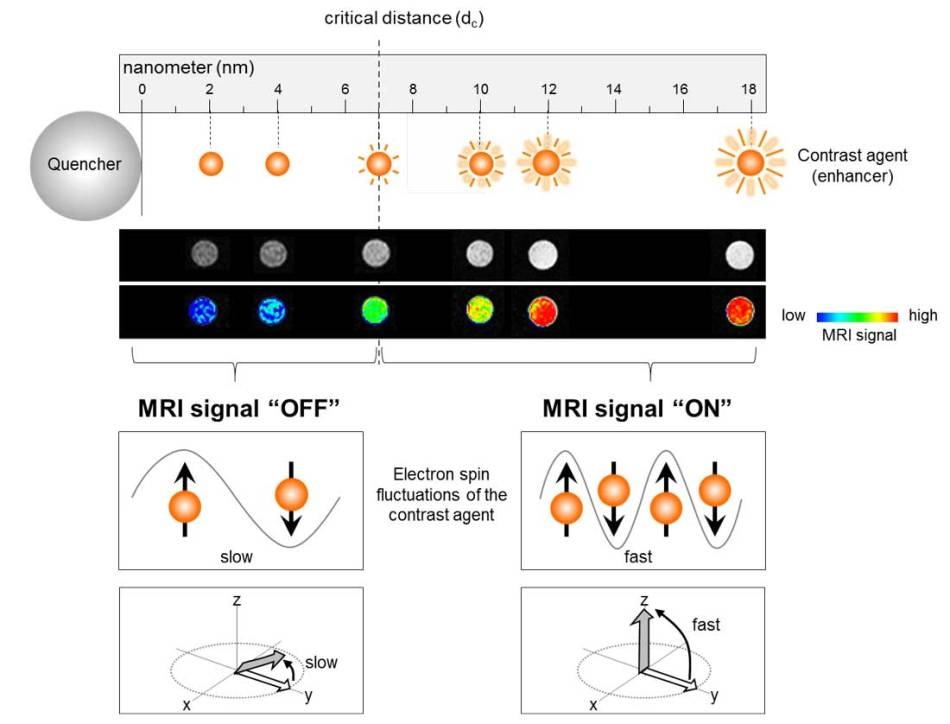Feb 7 2017
 The Nano MRI Lamp consists of two magnetic materials: A quencher (magnetic nanoparticle) and an enhancer (MRI contrast agent). The MRI signal depends on the distance between the two materials. The enhancer produces a bright MRI signal only when it is at a critical distance of at least 7 nm away from the quencher. The signal is due to the rapid fluctuations of the electron spins of the enhancer. A fast flipping of the electron spins influences the water molecule, whose energy emission is detected as MRI signals. (CREDIT: IBS)
The Nano MRI Lamp consists of two magnetic materials: A quencher (magnetic nanoparticle) and an enhancer (MRI contrast agent). The MRI signal depends on the distance between the two materials. The enhancer produces a bright MRI signal only when it is at a critical distance of at least 7 nm away from the quencher. The signal is due to the rapid fluctuations of the electron spins of the enhancer. A fast flipping of the electron spins influences the water molecule, whose energy emission is detected as MRI signals. (CREDIT: IBS)
A new technology platform, the Nano MRI Lamp, is capable of tuning the magnetic resonance imaging (MRI) signals "ON" only in the vicinity of the targeted disease. This platform was developed by a research team led by Cheon Jinwoo at the Center for Nanomedicine, within the Institute for Basic Science (IBS).
This study can surpass the limitations of currently prevalent MRI contrast agents. The details of the research were published in Nature Materials.
MRI is a non-invasive method for diagnosis that is increasingly popular as it does not use destructive radiation. Certain tissues display a natural contrast on MRI, but for certain specific types of imaging, patients are given a MRI contrast agent to increase the difference between the target area and the rest of the body.
Typical MRI contrast agents, like gadolinium, are injected in an "ON" state and distributed across the whole biological system with relatively large background signal. We found a new principle to switch the MRI contrast agent "ON" only in the location of the target.
Cheon Jinwoo, IBS
IBS researchers discovered how to turn the signal ON/OFF using the Nano MRI Lamp.
The Nano MRI Lamp technology comprises of two magnetic materials: An enhancer (MRI contrast agent) and a quencher (magnetic nanoparticle). The switch is due to the distance between the two. When the two materials are positioned closer than 7 nm, the MRI signal is "OFF", whereas when they are at a critical distance, beyond 7 nm, the MRI signal is "ON".
The team christened this phenomenon Magnetic REsonance Tuning (MRET), which is similar to the powerful optical sensing method called Fluorescence Resonance Energy Transfer (FRET).
The Nano MRI Lamp was tested by the researchers to diagnose cancer. The presence of an enzyme that can stimulate tumor metastasis, MMP-2 (matrix metalloproteinase-2) in mice with cancer was detected. The researchers connected the two magnetic materials using a linker that is naturally cleaved by MMP-2.
As the linker maintains the two materials close together, the MRI signal was "OFF". However, when cancer was present, the linker is cleaved by MMP-2, which results in the two materials becoming separated and the MRI signal being switched "ON". Thus, the MRI signal revealed the location of MMP-2, and the tumor. The researchers also discovered that the MRI signal’s brightness matches with the concentration of MMP-2 in the tumor.
Most notably, the Nano MRI Lamp stays on “OFF” mode until it meets a biomarker linked with a specific disease, thus allowing better sensitivity.
The current contrast agent is like using a flashlight during a sunny day: Its effect is limited. Instead, this new technology is like using a flash light at night and therefore more useful.
Cheon Jinwoo, IBS
In addition to cancer diagnosis, in theory the Nano MRI Lamp can be used to analyze a number of biological events, such as pH variation, enzymolysis, and protein-protein interactions. IBS researchers suppose that it would be practical for both in vivo and in vitro diagnostics.
Although we still have a long way to go, we established the principle and believe that the MRET and Nano MRI Lamp can serve as a novel sensing principle to augment the exploration of a wide range of biological systems.
Cheon Jinwoo, IBS
The research team is currently involved in developing smarter and safer multitasking contrast agents, which can record and interpret numerous biological targets at the same time, and ultimately allow a better comprehension of biological processes and accurate diagnosis of diseases.